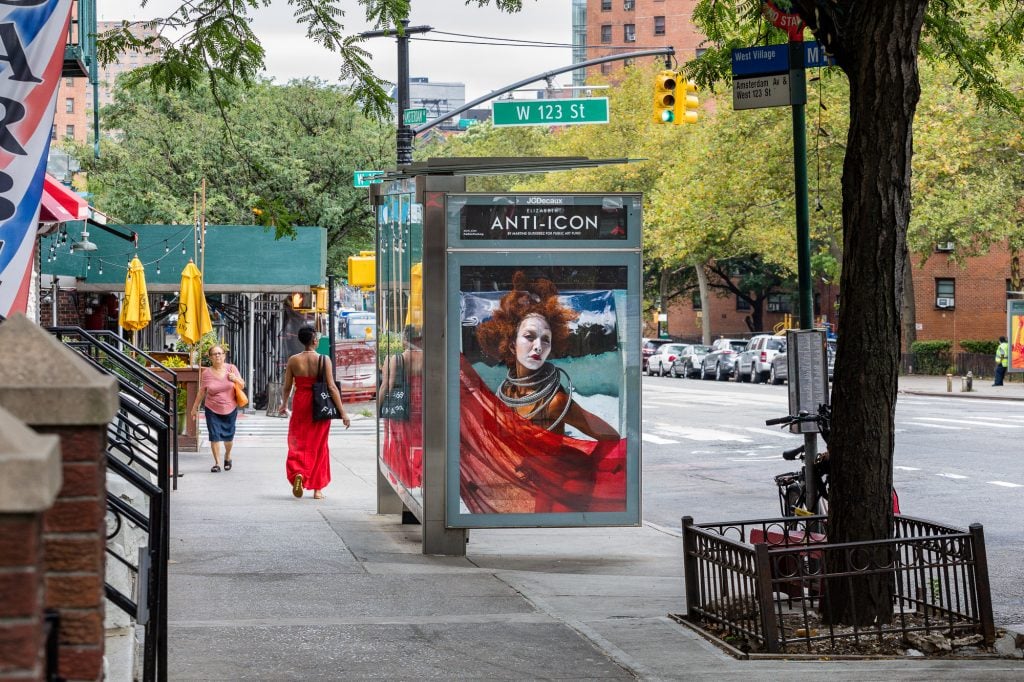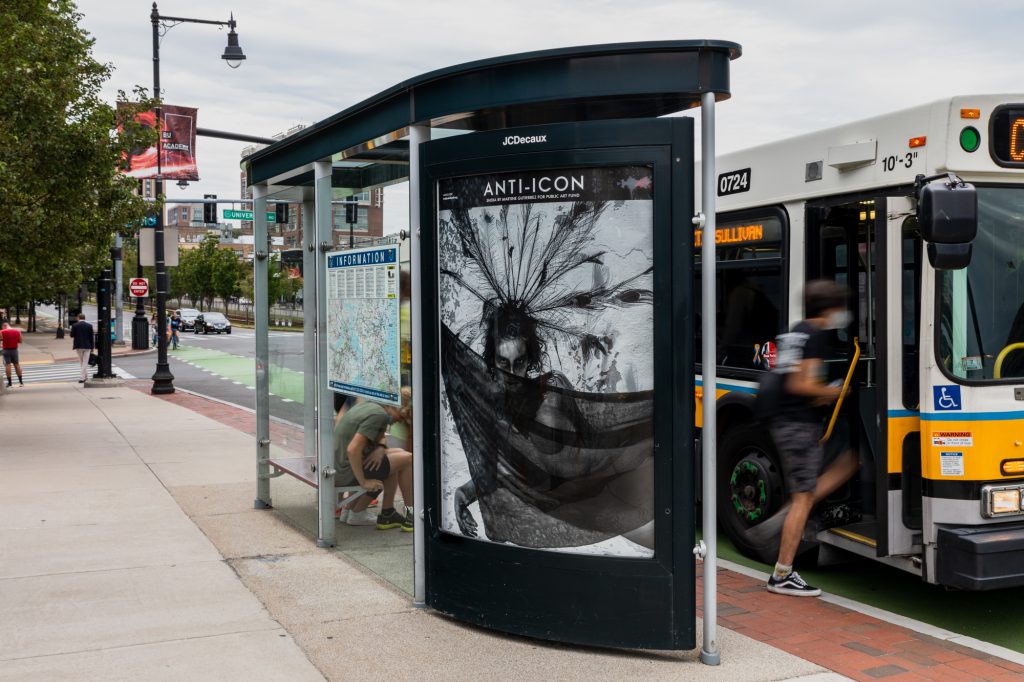Art World
How Martine Gutierrez Turned Herself Into Cleopatra, Mulan, and Other Historical Heroines for a Public Art Project in Bus Shelters Across the U.S.
"I want to make something on my own terms," Gutierrez said.

"I want to make something on my own terms," Gutierrez said.

Osman Can Yerebakan

The artist Martine Gutierrez was just one locked door away from Madonna—the icon she’d love to photograph more than anyone—while the queen of pop was performing for a Pride celebration at the Manhattan club Boom Boom Room. Gutierrez had a ticket, but was running late from photographing a shoot for Interview magazine. When at last she arrived, bearing a bouquet of roses, she told the pitiless bouncer that she needed to give the flowers to Madonna. The bouncer, however, was too preoccupied with all the frenzied fans punching, pulling hair, and clawing to reach their queen.
Gutierrez and her friends gave up and sought refuge at the nearby piers. “We instead released the roses to the Hudson River and made wishes about what we want from New York,” she told Artnet News. Commiserating helped the artist feel like she had met her icon. “Getting to know Madonna in person one day,” should Gutierrez ever be able to photograph her, “would shatter my ideal for who she is, and that would be healthy for me,” she said. Gutierrez has learned that it’s often less interesting to capture iconic figures in the flesh than it is to conquer their mythology from the inside out.
The multi-hyphenate artist’s sleek and mysterious photographs, in which she is both the subject and the photographer, have recently made star-turn appearances in the Venice Biennale, the Ljubljana Biennial of Graphic Arts, at London’s Hayward Gallery, and at the Australian Center for Photography.
Now, “Anti-Icon,” Gutierrez’s new multi-city exhibition on the streets of New York, Chicago, and Boston transfers her play between gaze and muse to the public realm. For a series of photographs lining 300 bus shelters, organized by the Public Art Fund, the Brooklyn-based artist reenacts 10 historical or mythological female icons.
Martine Gutierrez, Cleopatra (2021). Courtesy of the artist.
“We know an icon like Madonna in her every form, but no one thinks of Aphrodite or Cleopatra as a child or as aged,” Gutierrez said. “Once everything burns down, we will still run back to mythology because we need it to make sense of our lives—this annotation of storytelling is bigger than the internet.”
Gutierrez, who is 32, shot her renditions of Cleopatra, Mulan, Queen of Sheba, Atargatis, Gabriel, Aphrodite, Lady Godiva, Helen of Troy, Queen Elizabeth I, and Judith last summer at her mother’s house in upstate New York. There had been a drought that season, sapping the vitality of the usually lush landscape in a way that mirrored the pandemic’s effect on Gutierrez’s own creative spirit. But after searching for inspiration in mythology, she realized that she, too, could defy the limitations of her surroundings. The empty pool, where she had already moved a mattress to create a private room of her own, became her studio, while the materials she found around the house turned into her props. Then she clicked on the timer.
Gutierrez had initially envisioned the 10 icons wearing gaudy costumes; one idea was even to create a series of faux perfume ads for a fictional fragrance called Anti-Icon. “But it felt wrong to make something decorated during times of scarcity,” she said. Instead, cuts of tarp became Helen’s dress, inspired by 1960s Italy, and she hides her sultry expression in the photo behind a veil of bird netting. Meanwhile, the peonies Aphrodite clutches to conceal her breasts come from a surplus at Gutierrez’s mother’s garden. Mulan’s body shield is made of plaster, while gauze, mud, sticks, trash bags, cardboard, and zip ties substitute for Elizabeth’s crown, Gabriel’s wings, and other markers of female deity.

Martine Gutierrez, (2021), Boston. Courtesy the artist and RYAN LEE Gallery. Photo: Mel Taing, Courtesy of Public Art Fund, NY.
When we met in Brooklyn last month to visit some of the shelter images, which appear in JCDecaux ad spaces, Gutierrez donned a pair of Tomb Raider-esque shorts, a short shirt, and earthy sandals. “Don’t I look like Lara Croft today?” she asked.
Seeing her Aphrodite in a Clinton Hill bus shelter, Gutierrez screamed, “Oh my god she’s gorgeous!”
The woman in the picture and the artist standing next beside her looked very different, I noted. Gutierrez agreed: “That’s not me in there.”
The grandiose femininity of the trans body in the image contrasted sharply with the ad for Clint Eastwood’s new Western Cry Macho on the shelter’s opposite end, which is why the commercial context for this work is so fitting. Beyond their gloss, the meticulously constructed images deconstruct female sexuality and defy the default male gaze—while penetrating into a space reserved for commercial beauty. For Gutierrez, the trappings of celebrity also represent a personal pain: “When I was younger, I thought if I were famous people would finally accept me,” she said.
Born to a Guatemalan father and a white American mother in California, Gutierrez gradually transitioned to a female identity over the years. Her practice has continuously reflected this self-construction both as a woman and an artist through works that combine her make-do creative spirit with an innate urge for self-discovery. In Girlfriends (2014), her own image blends into frames with look-alike mannequins; for Indigenous Woman (2018), she stars in a 124-page fictional fashion magazine about Indigenous identity and attire. The images’ polished veneers disguise the found objects and unconventional backgrounds within them as they orchestrate illusions of both reality and fiction.
“There is nothing you see that is not true—as long as it’s what you want to see,” Gutierrez said.
The artist considers curator Ralph Rugoff’s exhibition for the 2019 Venice Biennale a turning point in her career. It was also a time when she felt physically beautiful. Italians kept calling her Monica Bellucci, whose style in the 2000 drama Malèna ended up becoming an inspiration for her Helen. “Being a beautiful woman cuts you through wealth and class—you can be broke but people will pay attention,” she said. “Men think I am there for them, and to be made an object is a corrupting feeling.”
Martine Gutierrez, Godiva (2021). Courtesy of the artist.
Beauty, as she learned by making “Anti-Icon,” can also be triggering. The photographs’ public presence forced her to shoot each image with her body parts strategically covered. “They’re still nudes, but different kinds,” Gutierrez said. She avoids using the word “censor,” preferring “conceal” or “reveal” for a little more mystery.
“If Madonna had a penis, she’d definitely show it to everyone,” she laughed. (The queen of pop’s infamous Sex book of 1992 was in the artist’s mood board for the project.)
Posing for a man’s lens, however, is an experience Gutierrez avoids. “I’d critique myself to a degree of self-bullying,” she said. On the other hand, Gutierrez’s own relationship with using the camera is still a work in progress. She positions her body and expressions suggestively, somewhere between performance and acting.
“I am not self-aware enough to control my expressions yet,” the artist said. Experience has taught her to try to forget the lens and timer, and she reviews the results to find the moments of authenticity.
This month, another vision of Gutierrez will appear in public when the Whitney opens its commission of work by the artist for its billboard series across from the High Line. This time, Gutierrez is pictured looking away from the lens, dressed in colorful attire with Indigenous patterns and surrounded by collages of nature imagery. Like her other juxtapositions, the scene presents a hyper-stylized version of what could pass as an advertisement—the billboard is perched over Manhattan’s posh Meatpacking District—as well as an overly performative display of a culture, presumably for the default white gaze.
“I’ve developed a sense of autonomy and confidence with safety of not having to barter my qualifiers for the sake of cashing in or relevancy,” she said. “Moving through the world so intuitively, I want to be able to make something only on my own terms.”
“Martine Gutierrez: Anti-Icon” is on view through November 21, 2021.